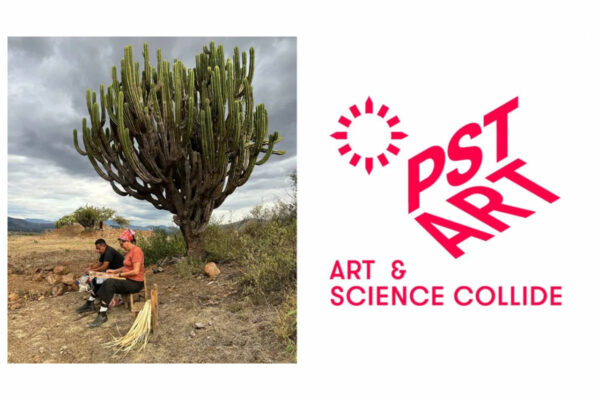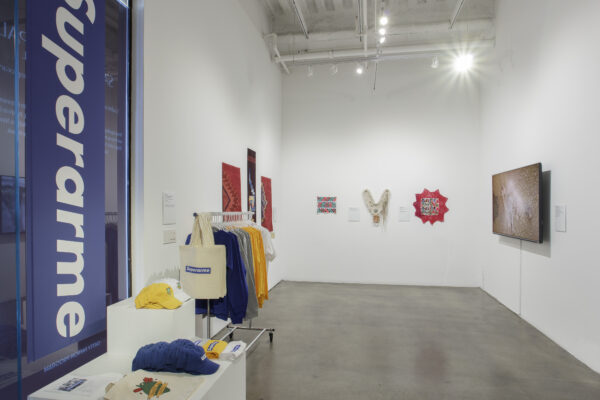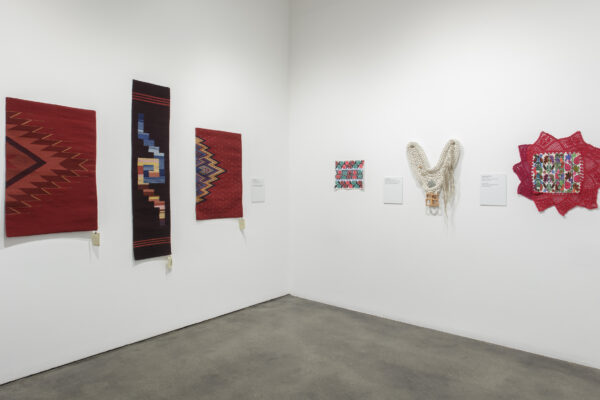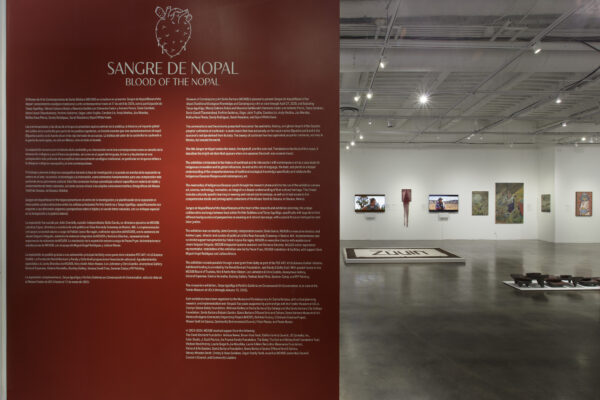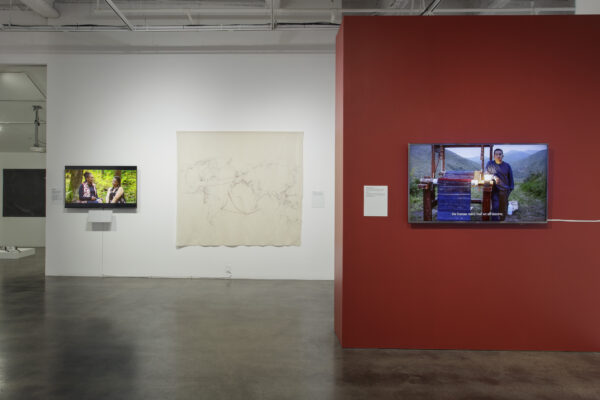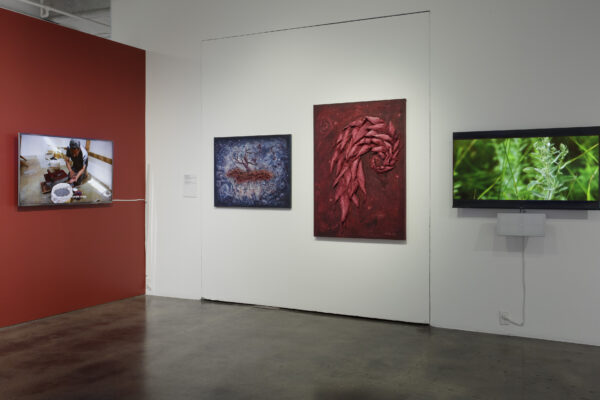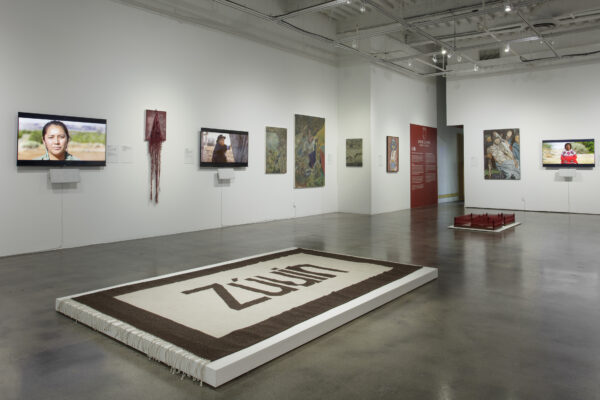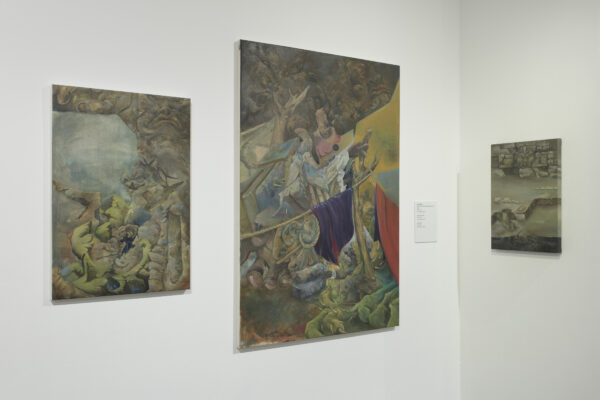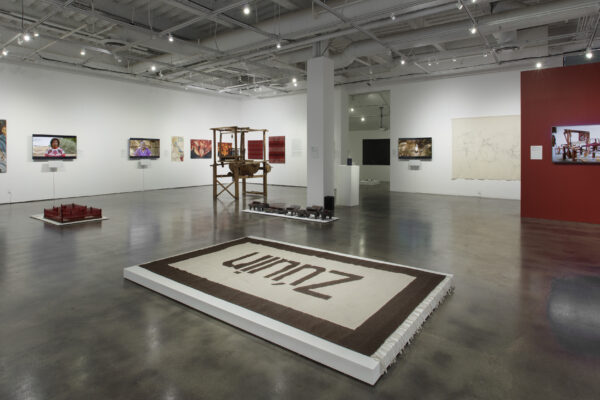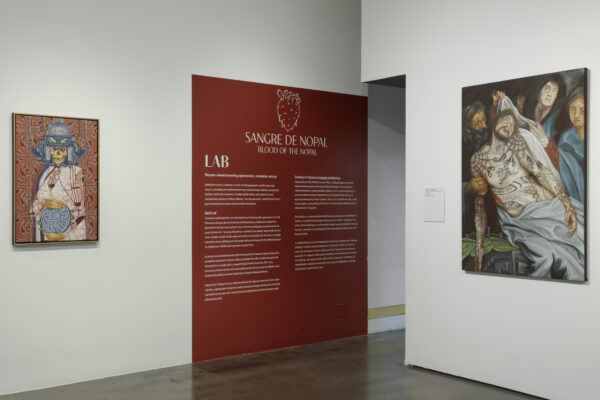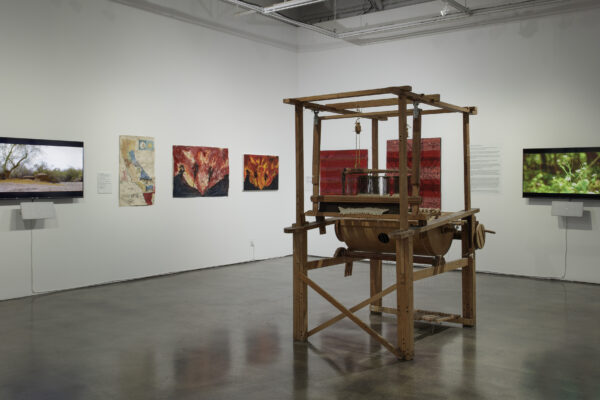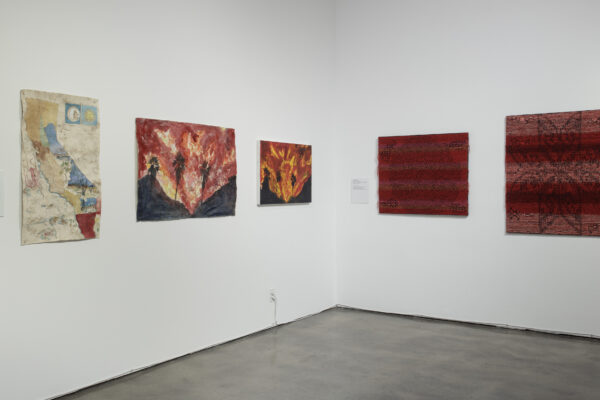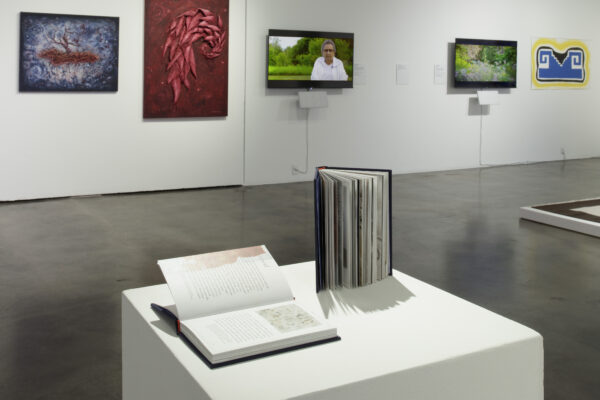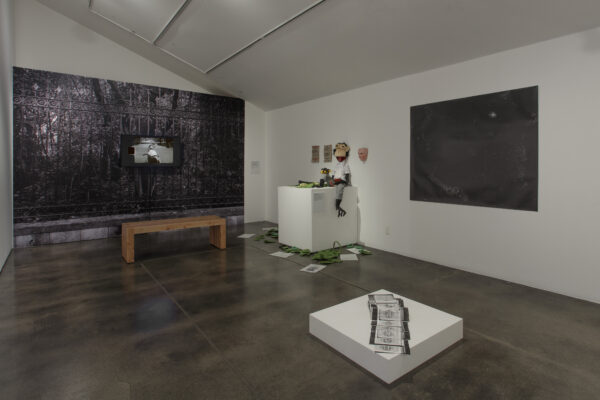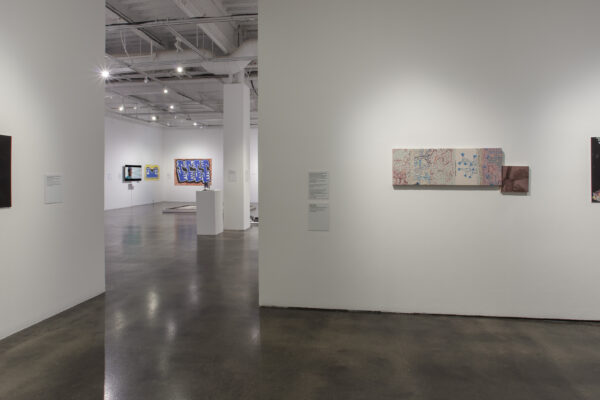Sangre de Nopal/Blood of the Nopal: Traditional Ecological Knowledge and Contemporary Art is among more than 70 exhibitions and programs presented as part of PST ART. Returning in September 2024 with its latest edition, PST ART: Art & Science Collide, this landmark regional event explores the intersections of art and science, both past and present. PST ART is presented by Getty. For more information about PST ART: Art & Science Collide, please visit pst.art.
Please also visit the companion exhibition: Sangre de Nopal/Blood of the Nopal: Tanya Aguiñiga and Porfirio Gutiérrez en Conversación/in Conversation currently on view at the Fowler Museum at UCLA.
(Español abajo)
Museum of Contemporary Art Santa Barbara (MCASB) is pleased to present Sangre de Nopal/Blood of the Nopal:Traditional Ecological Knowledge and Contemporary Art on view through April 27, 2025, and featuring Tanya Aguiñiga, Wendy Cabrera Rubio and Mauricio Guillén with Clemente Castor and Antonio Ponce, Tania Candiani, Dario Canul (Tlacolulokos), Porfirio Gutiérrez, Edgar Jahir Trujillo, Candice Lin, Andy Medina, Jou Morales, Rufina Nava Flores, Sandy Rodriguez, Sarah Rosalena, and Dyani White Hawk.
Click here for Artist Biographies
The conversations and the artworks presented here center the aesthetics, history, and global impact of the Zapotec peoples’ cultivation of cochineal—a scale insect that lives exclusively on the nopal cactus (Opuntia cacti) and is the source of a red dye derived from its body. The beauty of cochineal hue has captivated people for centuries, not only in Mexico, but around the world.
The title Sangre de Nopal evokes the insect, the dyestuff, and the color red. Translated as the blood of the nopal, it describes the bright red stain that appears when one squeezes the small, wax-covered insect.
The exhibition is interested in the history of cochineal and its intersection with contemporary art as a case study for Indigenous innovation and its global influences. As well as the role of language, the land, and plants in a deeper understanding of the comprehensiveness of traditional ecological knowledge specifically as it relates to the Indigenous Oaxacan Diaspora and contemporary art.
The mentorship of Indigenous Oaxacan youth through the research phase and into the run of the exhibition centers art, science, technology, innovation, as integral to a deeper understanding of their cultural heritage. This thread includes culturally specific learning in weaving and natural dye knowledge, as well as virtual access to the comprehensive textile and photographic collections of the Museo Textil de Oaxaca, in Oaxaca, Mexico.
Sangre de Nopal/Blood of the Nopal features at the heart of the research and exhibition planning, the unique collaborative exchange between lead artists Porfirio Gutiérrez and Tanya Aguiñiga, specifically with regards to their different backgrounds and perspectives on weaving and natural dye usage, with a special focus on immigration and labor justice.
The exhibition was curated by John Connelly, independent curator; Dalia Garcia, MCASB co-executive director; and Audrey Lopez, director and curator of public art at the Rose Kennedy Greenway in Boston, MA. Implementation and curatorial support was provided by Fabián Leyva-Barragán, MCASB co-executive director with assistance of Jessie Salgado Delgado, MCASB integrated systems assistant and Veronica Sánchez, MCASB visitor experience representative. Installation of the exhibition was led by Pecos Pryor, MCASB installation & facilities, with support from Miguel Angel Rodriguez and Juliana Moore.
The exhibition is made possible through a lead grant from Getty as part of the PST ART: Art & Science Collide initiative. Additional funding is provided by the David Bermant Foundation, and Randy & Sofia Greif. With special thanks to the MCASB Board of Trustees, Kim & Keith Allen-Niesen, Lori Johnston & Chris Castillo, Anonymous Gallery, General Expenses, Galeria Vermelho, Various Small Fires, Summer Camp, and PIP Printing.
Both Sangre de Nopal/Blood of the Nopal exhibitions have been organized by the Museum of Contemporary Art Santa Barbara, with critical planning, research, and implementation over the past four years supported by partnerships with the Fowler Museum at UCLA, Carolyn Glasoe Bailey Foundation, Atkinson Gallery at Santa Barbara City College and the Santa Barbara City College Foundation, Santa Barbara Botanic Garden, Santa Barbara Office of Arts and Culture, Santa Barbara Museum of Art, Mixteco/Indigena Community Organizing Project (MICOP), Bell Arts Factory, Children’s Creative Project, Museo Textil de Oaxaca, Community Environmental Council, Prism Places and Paseo Nuevo.
In 2023–2024, MCASB received support from the following:
The David Bermant Foundation, Melissa Bower, Brown Voss Trust, California Arts Council, JC Connelly, Inc., Eider Studio, J. Scott Francis, the Francis Family Foundation, The Getty, The Earl and Shirley Greif Foundation Trust, Michael MacElhenny, Randy & Sofia Greif, Laurie Siegel & Joe Nosofsky, Laurie & Marc Recordon, Resonance Foundation, Richard & Ro Sanders, Santa Barbara Foundation, Santa Barbara County Office of Arts & Culture, Wendy Wheeler Smith, Christy & Hans Swildens, Zegar Family Fund, as well as MCASB Leadership Council, Curator’s Council, and Community Leaders.
(Español)
El Museo de Arte Contemporáneo de Santa Bárbara (MCASB) se complace en presentar Sangre de Nopal/Blood of the Nopal: conocimiento ecológico tradicional y arte contemporáneo hasta el 27 de abril de 2025, con la participación de Tanya Aguiñiga, Wendy Cabrera Rubio y Mauricio Guillén con Clemente Castor y Antonio Ponce, Tania Candiani, Darío Canul (Tlacolulokos), Porfirio Gutiérrez, Edgar Jahir Trujillo, Candice Lin, Andy Medina, Jou Morales, Rufina Nava Flores, Sandy Rodríguez, Sarah Rosalena y Dyani White Hawk.
Las conversaciones y las obras de arte que se presentan aquí se centran en la estética, la historia y el impacto global del cultivo de la cochinilla por parte de los pueblos zapotecas, un insecto escama que vive exclusivamente en el nopal (Opuntia cacti) y es la fuente de un tinte rojo derivado de su cuerpo. La belleza del color de la cochinilla ha cautivado a la gente durante siglos, no sólo en México, sino en todo el mundo.
La exposición se centra en la historia de la cochinilla y su intersección en el arte contemporáneo como un estudio de la innovación indígena y sus influencias globales, así como en el papel del lenguaje, la tierra y las plantas en una comprensión más profunda de la amplitud del conocimiento ecológico tradicional, en particular en lo que se refiere a la diáspora indígena oaxaqueña y al arte contemporáneo.
El tutelaje a jóvenes indígenas oaxaqueños durante la fase de investigación y la puesta en marcha de la exposición se centra en el arte, la ciencia, la tecnología y la innovación, como elementos fundamentales para una comprensión más profunda de su patrimonio cultural. Este hilo conductor incluye aprendizaje cultural específico en materia de tejido y conocimiento de tintes naturales, así como acceso virtual a las amplias colecciones textiles y fotográficas del Museo Textil de Oaxaca, en Oaxaca, México.
Sangre de Nopal/Blood of the Nopal presenta en el centro de la investigación y la planificación de la exposición el intercambio colaborativo único entre los artistas principales Porfirio Gutiérrez y Tanya Aguiñiga, específicamente con respecto a sus diferentes orígenes y perspectivas sobre el tejido y el uso de tintes naturales, con un enfoque especial en la inmigración y la justicia laboral.
La exposición fue curada por John Connelly, curador independiente; Dalia García, co-directora ejecutiva de MCASB; y Audrey López, directora y curadora de arte público en Rose Kennedy Greenway en Boston, MA. La implementación y el apoyo curatorial estuvo a cargo de Fabián Leyva-Barragán, codirector ejecutivo del MCASB, con la asistencia de Jessie Salgado Delgado, asistente de sistemas integrados de MCASB y Verónica Sánchez, representante de experiencia de visitantes de MCASB. La instalación de la exposición estuvo a cargo de Pecos Pryor, de instalaciones e instalaciones de MCASB, con el apoyo de Miguel Ángel Rodríguez y Juliana Moore.
La exposición es posible gracias a una subvención principal de Getty como parte de la iniciativa PST ART: Art & Science Collide. La Fundación David Bermant y Randy y Sofia Greif proporcionan financiación adicional. Agradecimientos especiales a la Junta Directiva de MCASB, Kim y Keith Allen-Niesen, Lori Johnston y Chris Castillo, Anonymous Gallery, General Expenses, Galeria Vermelho, Various Small Fires, Summer Camp y PIP Printing.
La exposición complementaria, Tanya Aguiñiga y Porfirio Gutiérrez en Conversación/in Conversation, está a la vista en el Museo Fowler de UCLA hasta el 12 de enero de 2025.


